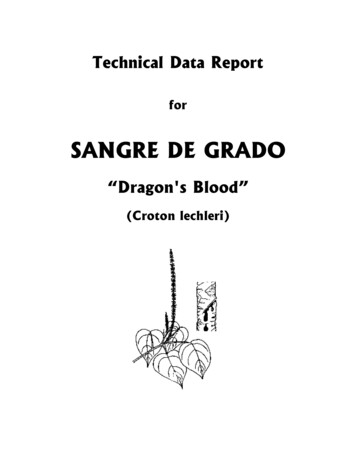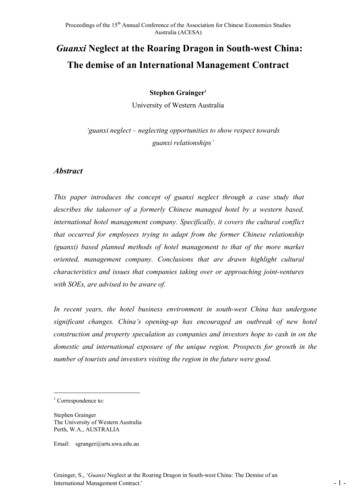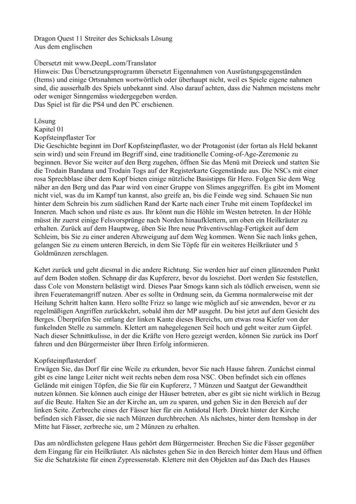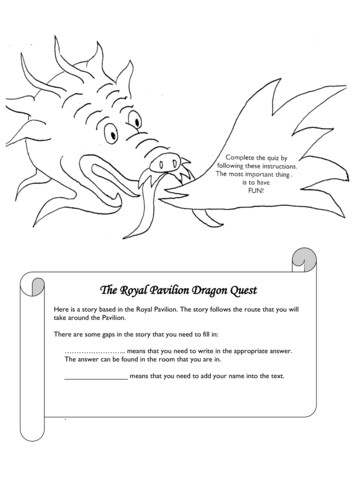
Transcription
Technical Data ReportforSANGRE DE GRADO“Dragon's Blood”(Croton lechleri)
Copyrighted 2002 - 2007. All rights reserved. No part of this document may be reproduced ortransmitted in any form or by any means, electronic or mechanical, including photocopying, recording,or by any information storage or retrieval system, without written permission.This document is not intended to provide medical advice and is sold with the understanding that thepublisher and the author are not liable for the misconception or misuse of information provided. Theauthor shall have neither liability nor responsibility to any person or entity with respect to any loss,damage, or injury caused or alleged to be caused directly or indirectly by the information contained inthis document or the use of any plants mentioned. Readers should not use any of the productsdiscussed in this document without the advice of a medical professional. Copyrighted 2002 and updated 2007 by Leslie Taylor, ND., 3579 Hwy 50 East, Suite 222, CarsonCity, NV 89701. All rights reserved.
Sangre de Grado"Dragon's Blood"Reprinted from the book The Healing Power of Rainforest Herbs Copyrighted 2005 by Dr. Leslie Taylor, ND and Square OnePublishers, Inc.Family: EuphorbiaceaeGenus: CrotonSpecies: lechleri, salutarisSynonyms: Croton dracoCommon Names: Sangre de grado, sangre de drago, dragon’s blood, drago, sangue dedrago, sangue de aguaParts Used: Bark, resin/sapHerbal Properties & ActionsMain Actions:Other Actions:Standard Dosage: Re sinheals woundskills cancer cellsInternal: 10-15 drops twic e dailystops bleedingprev ents tum or growthExtern al: Apply to affected areakills bacte riastops cellular mutationstwic e dailykills germ skills fungikills virusesrelieves diarrheareduces inflamm ationrelieves itchingSangre de grado is a medium to large-sized tree that grows from 10–20 m high in the upperAmazon region of Peru, Ecuador, and Colombia. Although tall, the trunk is usually less than 30 cmin diameter and is covered by smooth, mottled bark. It has large, heart-shaped, bright green leavesand unique, greenish-white flowers on long stalks. Its Peruvian name, sangre de grado, means“blood of the dragon” (in Spanish). In Ecuador, it’s named sangre de drago (which means “dragon’sblood” as well). When the trunk of the tree is cut or wounded, a dark red, sappy resin oozes outas if the tree is bleeding—earning this local name. The genus Croton is a large one, with 750species of trees and shrubs distributed across the tropical and subtropical regions of bothhemispheres. Crotons are rich in active alkaloids, and several species are well-known medicinalplants used as laxatives and tonics.TRIBAL AND HERBAL MEDICINE USESSangre de grado’s red sap or latex (and also its bark) has a long history of indigenous use inthe rainforest and in South America. The earliest written reference dates its use to the 1600s, whenSpanish naturalist and explorer P. Bernabé Cobo found that the curative power of the sap waswidely known throughout the indigenous tribes of Mexico, Peru, and Ecuador. For centuries, thesap has been painted on wounds to staunch bleeding, to accelerate healing, and to seal andprotect injuries from infection. The sap dries quickly and forms a barrier, much like a “second skin.”It is used externally by indigenous tribes and local people in Peru for wounds, fractures, andhemorrhoids, internally for intestinal and stomach ulcers, and as a douche for vaginal discharge.Other indigenous uses include treating intestinal fevers and inflamed or infected gums, in vaginalbaths before and after childbirth, for hemorrhaging after childbirth, and for skin disorders.1
Sangre de grado resin and bark are used in traditional medicine in South America today inmuch the same manner as indigenous ones. In Peruvian herbal medicine, it is recommended forhemorrhaging, as an antiseptic vaginal douche and, topically, for healing wounds. It is also usedinternally for ulcers in the mouth, throat, intestines, and stomach; as an antiviral for upperrespiratory viruses, stomach viruses, and HIV; internally and externally for cancer and, topically,for skin disorders, insect bites, and stings. In Brazilian traditional medicine, the sap currently isused for wounds, hemorrhaging, diarrhea, mouth ulcers, and as a general tonic.PLANT CHEMICALSSangre de grado resin or sap is a storehouse of phytochemicals, including proanthocyanidins(antioxidants), simple phenols, diterpenes, phytosterols, and biologically active alkaloids andlignans. Scientists have attributed many of the biologically active properties of the sap (especiallyits wound-healing capacity) to two main “active” constituents: an alkaloid named taspine,and alignan named dimethylcedrusine.Of course, botanists, herbalists, and naturopaths would disagree with such reductionistconclusions (and often do); in this particular case, the matter is actually proven by science. Notedauthor and ex-USDA economic botanist Dr. James Duke summed this up eloquently, saying,I like the comments on dragon’s blood, and would add one furthernote: in addition to the proanthocyanadins (including Pycnogenol)and taspines, there’s another active ingredient—dimethylcedrusine.While each of these alone—dimethylcedrusine, Pycnogenol andtaspine—was shown to effectively heal wounded rats (with squaresof skin exfoliated, i.e., peeled off) by European scientists, the wholedragon’s blood was shown to speed healing four times faster. Thewhole was better than the sum of its parts. Synergy makes thewhole herb stronger; diversity makes the rainforest stronger.1The taspine alkaloid from sangre de grado was first documented with antiinflammatory actionsin 1979.2 In 1985, taspine was documented with antiinflammatory, antitumorous (againstsarcomas), and antiviral actions.3The main plant chemicals in sangre de grado include alpha-calacorene, alpha-copaene, alphapinene, alpha-thujene, beta-caryophyllene, beta-elemene, beta-pinene, betaine, bincatriol, borneol,calamenene, camphene, catechins, cedrucine, crolechinic acid, cuparophenol, D-limonene,daucosterol, dihydrobenzofuran, dimethylcedrusine, dipentene, eugenol, euparophenol, gallocatechin, gamma-terpinene, gamma-terpineol, hardwickiic acid, isoboldine, korberin A and B, lignin,linalool, magnoflorine, methylthymol, myrcene, norisoboldine, p-cymene, proanthocyanidins, procyanidins, resin, tannin, taspine, terpinen-4-ol, and vanillin.BIOLOGICAL ACTIVITIES AND CLINICAL RESEARCHThe wound-healing action of sangre de grado resin was first related to the taspine alkaloid in1989.4 Several later studies also concentrated on the wound-healing5 and antitumorous propertiesof taspine.6 The lignan dimethylcedrusine was isolated by scientists in 1993 and was shown to playa central role in sangre de grado’s effective wound-healing action.7 This Belgian study revealed thatthe crude resin stimulated contraction of wounds, helped in the formation of a crust/scab at thewound site, regenerated skin more rapidly, and assisted in the formation of new collagen. This wasthe study to which Dr. Duke referred in documenting that the crude resin was found to be four timesmore effective at wound healing and collagen formation than its isolated chemicals (and healedwounds ten to twenty times faster than using nothing at all).7The Belgian scientists also determined that taspine was active against herpes virus in this2
study. In 1994 other phytochemicals were found, including phenolic compounds, proanthocyanadins, and diterpenes, which showed potent antibacterial activity (against E. coli and Bacillussubtilis) as well as wound-healing properties.8 Another study documented sangre de grado’santioxidant effects9 and researchers in Canada documented its antifungal properties.10Another important traditional use of the sap was verified by clinical research in a 2000 studydesigned to evaluate its gastrointestinal effects. Researchers concluded that “Sangre de grado isa potent, cost-effective treatment for gastrointestinal ulcers and distress via antimicrobial, antiinflammatory, and sensory afferent-dependent actions.”11 In 2002, these same researchersreported that sangre de grado evidenced an in vitro effect against stomach cancer and coloncancer cells as well.12 In 2003, Italian researchers reported that the resin inhibited the growth ofa human myelogenous leukemia cell line and also prevented cells from mutating in test tubestudies.13Extracts of sangre de grado have demonstrated antiviral activity against influenza,parainfluenza, herpes simplex viruses I and II, and hepatitis A and B.7, 8,14,15 The antiviral and antidiarrhea properties of sangre de grado have come to the attention of the pharmaceutical industryover the last ten years. A U.S.-based pharmaceutical company has filed patents on threepharmaceutical preparations that contain antiviral constituents and novel chemicals (a group ofplant flavonoids they’ve named SP-303), extracted from the bark and resin of sangre de grado.Their patented drugs include an oral product for the treatment of respiratory viral infections, atopical antiviral product for the treatment of herpes, and an oral product for the treatment ofpersistent diarrhea. These products have been the subject of various human clinical trials. Althoughthe immunomodulating effects of sangre de grado have not been the subject of targeted researchyet, some researchers believe that the anti-inflammatory, antimicrobial, and antioxidant activitiesmay provide nonspecific immune enhancement effects as well.16More recently, several scientific tests have been conducted on a proprietary sangre de gradoproduct (made into a skin balm), which was also based on traditional uses. They reported that inpest control workers, a sangre de grado balm was preferred over placebo, for the relief of itching,pain, discomfort, swelling, and redness in response to wasps, fire ants, mosquitoes, bees, cuts,abrasions, and allergic plant reactions (poison ivy and others).17 Subjects reported relief withinminutes, and that it provided pain relief and alleviated symptoms (itching and swelling) for up to sixhours. These reported effects in humans, as well as several other tests they conducted in animalsand in vitro models of inflammation, led them to conclude that sangre de grado prevents painsensation by blocking the activation of nerve fibers that relay pain signals to the brain (thereforefunctioning as a broad-acting pain killer), as well as blocking the tissue response to a chemicalreleased by nerves that promotes inflammation.CURRENT PRACTICAL USESResearch has confirmed many of the indigenous uses of this powerful rainforest plant. It is awonderful, sustainable rainforest resource that warrants consumer attention as it becomes morewidely available in the marketplace. Applied directly to the affected area, it is helpful for all typesof cuts, scrapes, external wounds, bites, stings, rashes, and skin problems, including skin andnail fungi. James E. Williams, OMD, sums up sangre de grado’s many uses by natural healthpractitioners, stating:There is a wide range of potential applications for sangre de grado, including as a broadspectrum anti-diarrheal agent from causes such as side effects of drugs, chemotherapyor radiation treatment, microbial infections of the intestine, traveler’s diarrhea, and viralinduced diarrhea as in AIDS. It may also have other uses in gastrointestinal disorderssuch as irritable bowel syndrome and ulcerative diseases. Its cytotoxic effects make it apossible antitumor agent and its cicatrizant properties provide wound-healing potential.In addition, the antimicrobial and anti-inflammatory effects of sangre de grado make it a3
useful compound in the clinical treatment of chronic viral diseases and as a naturalantibacterial agent.15In addition, several health practitioners in the U.S. indicate benefits in using sangre de gradoresin internally for diabetic neuropathy because of its previously documented effects on nerveendings, nerve pain, and nerve inflammation. Benefits have also been reported with diabetesrelated skin ulcers and sores (applied topically), which have refused to heal using other methods.TRADITIONAL PREPARATIONFor external use, the resin/sap is rubbed directly on the affected area several times daily andallowed to dry. Please note: the resin is red! It will temporarily stain the skin a reddish-brown (whichwill wash off), but it will permanently stain clothing. Rubbing the resin in the palm of the hand firstor directly where applied will thicken the resin into a thin, lighter colored paste, which helps forma second skin on top of a wound or rash and reduces staining. For internal use, the traditionalremedy is 10–15 drops in a small amount of liquid, taken one to three times daily (be prepared,however; it tastes quite dreadful).Contraindications: None reported.Drug Interactions: None reported.Worldwide Ethnomedical UsesRegionUsesBrazilfor bacterial infections, blood cleansing, cancer,digestive disorders, fever, fungal infections,hemorrhages, stomach ulcers, tumors, ulcer (mouth),wounds, and for its astringent (drying) effectsDominicanRepublicfor wounds, and to stop bleedingEcuadorfor cancer, inflammation, woundsMexicofor fever, infected gums, woundsPerufor cancer, diabetes, diarrhea, eczema, fractures,fungal infections, gastrointestinal problems,hemorrhages, hemorrhoids, infected gums,infections, insect bites, laryngitis, rheumatism, skincancer, skin rashes, throat problems, toothache,tumors, ulcers (intestinal, mouth, stomach), vaginaldischarge, vaginal infections, vaginitis, wounds, andas an antisepticUnited Statesfor cancer, diabetic neuropathy, eczema, fungalinfections (skin, nail, foot), hemorrhages,inflammation, insect bites, itching, pain, rashes,ulcers (intestinal, mouth, skin, stomach), wounds,and as an antiseptic4
uke, James A. “Added Comments on the Rainforest” Whole Foods Magazine, May 1997.Perdue, G. P., et al. “South American plants II: Taspine isolation and anti-inflammatoryactivity.” J. Pharm. Sci. 1979; 68(1): 124–26.Vlietinck, A. J. and R. A. Dommisse, eds. Advances in Medicinal Plant Research. Stuttgart:Wiss. Verlag, 1985.Vaisberg, A. J., et al. “Taspine is the cicatrizant principle in sangre de grado extracted fromCroton lechleri.” Planta Med. 1989; 55(2): 140–43.Porras-Reyes, B. H., et al. “Enhancement of wound healing by the alkaloid taspine definingmechanism of action.” Proc. Soc. Exp. Biol. Med. 1993; 203(1): 18–25.Itokawa, H., et al. “A cytotoxic substance from sangre de grado.” Chem. Pharm. Bull. (Tokyo)1991; 39(4): 1041–42.Pieters, L., et al. “Isolation of a dihydrobenzofuran lignan from South American dragon’sblood (Croton sp.) as an inhibitor of cell proliferation.” J. Nat. Prod. 1993; 56(6): 899–906.Chen, Z. P., et al. “Studies on the anti-tumour, anti-bacterial, and wound-healing propertiesof dragon’s blood.” Planta Med. 1994; 60(6): 541–45.Desmarchelier, C., et al. “Effects of sangre de drago from Croton lechleri Muell.-Arg. on theproduction of active oxygen radicals.” J. Ethnopharmacol. 1997; 58: 103–8.Macrae, W. D., et al. “Studies on the pharmacological activity of Amazonian Euphorbiaceae.”J. Ethnopharmacol. 1988; 22(2): 143–72.Miller, M. J., et al. “Treatment of gastric ulcers and diarrhea with the Amazonian herbalmedicine sangre de grado.” Am. J. Physiol. Gastrointest. Liver Physiol. 2000; 42: G192–200.Sandoval, M., et al. “Sangre de grado Croton palanostigma induces apoptosis in humangastrointestinal cancer cells.” J. Ethnopharmacol. 2002; 80(2-3): 121–9.Meza E. N., ed. Desarrollando Nuestra Diversidad Biocultural: “Sangre de Grado" y el Retode su Producción Sustentable en el Perú. Lima: Universidad Nacional Mayor de San Marcos;1999.Sidwell R., et al. “Influenza virus-inhibitory effects of intraperitoneally and aerosoladministered SP-303, a plant flavonoid.” Chemotherapy 1994; 40(1): 42–50.Williams, J. E. “Review of antiviral and immunomodulating properties of plants of thePeruvian rainforest with a particular emphasis on Una de Gato and Sangre de Grado.” Altern.Med. Rev. 2001; 6(6): 567–79.Miller, M. J., et al. “Inhibition of neurogenic inflammation by the Amazonian herbal medicinesangre de grado.” J. Invest. Dermatol. 2001; 117(3): 725–30.The information contained herein is intended for education, research, and informational purposesonly. This information is not intended to be used to diagnose, prescribe or replace proper medicalcare. The statements contained herein have not been evaluated by the Food and Drug Administration. The plant described herein is not intended to diagnose, treat, cure, mitigate, or prevent anydisease.5
Ethnomedical Information on Sangre de Grado (Croton lechleri)Plant Part / LocationDocum ented Ethnic UseType Extract / Rou teUsed ForRef #Latex Am azo niaUsed externally for wounds, taken internally for intestinal fevers andpyorrhea.Latex / VariousHum an AdultAS1003Latex Am azo niaTaken orally in hot water to hasten internal healing following an abortion.Used to stop bleeding and heal wounds.Used as a vaginal douche after childbirth.Used for tuberculoisis and bone ca ncer.LatexLatexLatexLatex/ Oral/ External/ Douche/ OralHum an AdultZZ1011Latex Am azo niaUsed for wound healing.Used for internal inflamm ation, ulcers and cance r.Latex / ExternalLatex / OralHum an AdultZZ2007Latex BrazilUsed to treat wounds and as a protection against bacterial and fungalinfections to wounds.Latex / ExternalHum an AdultZZ1099Latex BrazilUsed for wounds, hemorrhaging, mouth ulcers and a general tonic.Latex / Oral & ExternalHum an AdultZZ1013Latex EcuadorUsed for inflamm ation and the treatment of wounds.Latex / ExternalHum an AdultH11766Latex EcuadorUsed for cancer.Latex / External & OralHum an AdultH11766Latex PeruUsed as a cicatrizant and hemostat for wounds.Used for stomach, liver and uterine cancers, and stomach ulcers.Three drops of resin in a coca leaf tea with salt used for tonsilitis and sorethroa t.Resin mixed in a bath with Llanten herb used for vaginal infections andgonorrhea.Latex / ExternalLatex / InternalLatex / GargleHum an AdultZZ2009Latex PeruUsed for wound healing, in baths before childbirth.Latex / ExternalHum an AdultL04137Latex PeruUsed for stomach ulcers.Latex / OralHum an AdultL04137Latex PeruUsed as an anti-inflamm atory and vulnerary to heal wounds.Considered astringent, a ntio xidant, an tivira l, anti-tum oral, antiinflamm atory, antiangiogenic, and anti-cancerous.Latex / ExternalLatex / External & OralHum an AdultZZ2013Latex PeruUsed topically on skin cance r.Latex / ExternalHum an AdultH220276Late x / Ba th
Plant Part / LocationDocum ented Ethnic UseType Extract / Rou teUsed ForRef #Latex PeruUsed for rheumatism.Latex / OralHum an AdultN00002Latex PeruUsed for cancer.Latex / OralHum an AdultK10718Latex PeruUsed to improve gastrointestinal function, to protect the mucousmem brane lining of the lower gastrointestinal tract, and to treat diarrhea.Latex / OralHum an AdultAS1002Latex PeruUsed as an oral gargle for sore throat, as a vaginal antiseptic afterchildbirth, topically as a hemostatic, and taken internally for woundhealing.Latex / VariousHum an AdultAS1002Latex PeruUsed for for hemorrhaging, as an antiseptic vaginal douche, for wounds,and ulcers in the mouth, throat and stomach.Latex / OralHum an AdultZZ1008Latex PeruUsed for sore throat and laryngitis, toothaches, menstrual hemorrhages.Latex / OralHum an AdultZZ1093Latex PeruUsed for stomach and intestinal ulcers.Latex / OralHum an AdultZZ1045Latex PeruUsed for wounds, leucorrhea, fractures and piles.Latex / ExternalHum an AdultZZ1041Latex PeruUsed for wound healing.Latex / ExternalHum an AdultK10718Latex PeruUsed for wounds and sk in cancer.Used for cancer, high blood pressure, sore throat, infections, anddiabetes.Latex / ExternalHum an AdultZZ1084Latex PeruUsedUsedUsedUsedLatex / ExternalLatex / ExternalInfusion / DoucheLatex / OralHum an AdultZZ1101Latex PeruBark P e
author and ex-USDA economic botanist Dr. James Duke summed this up eloquently, saying, I like the comments on dragon’s blood, and would add one further note: in addition to the proanthocyanadins (including Pycnogenol) and taspines,











